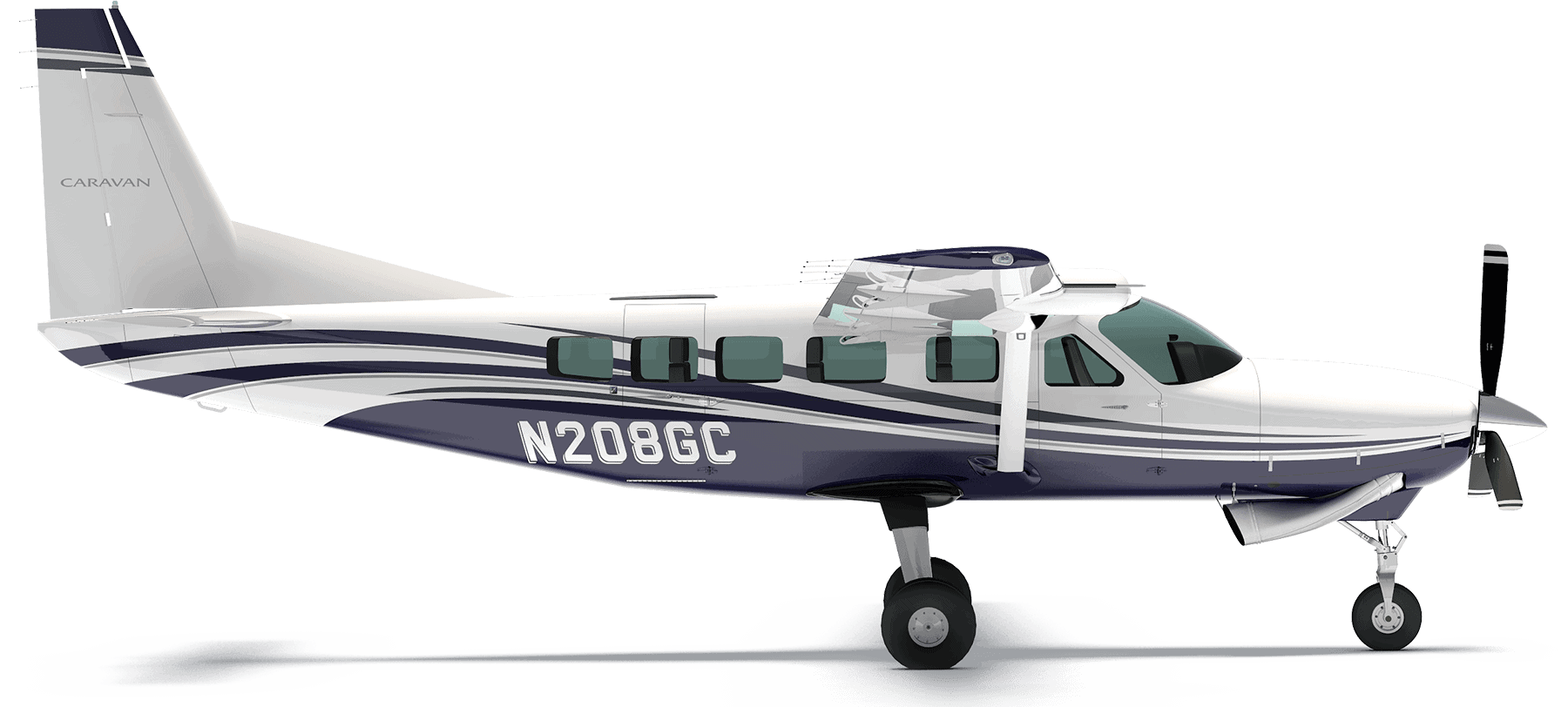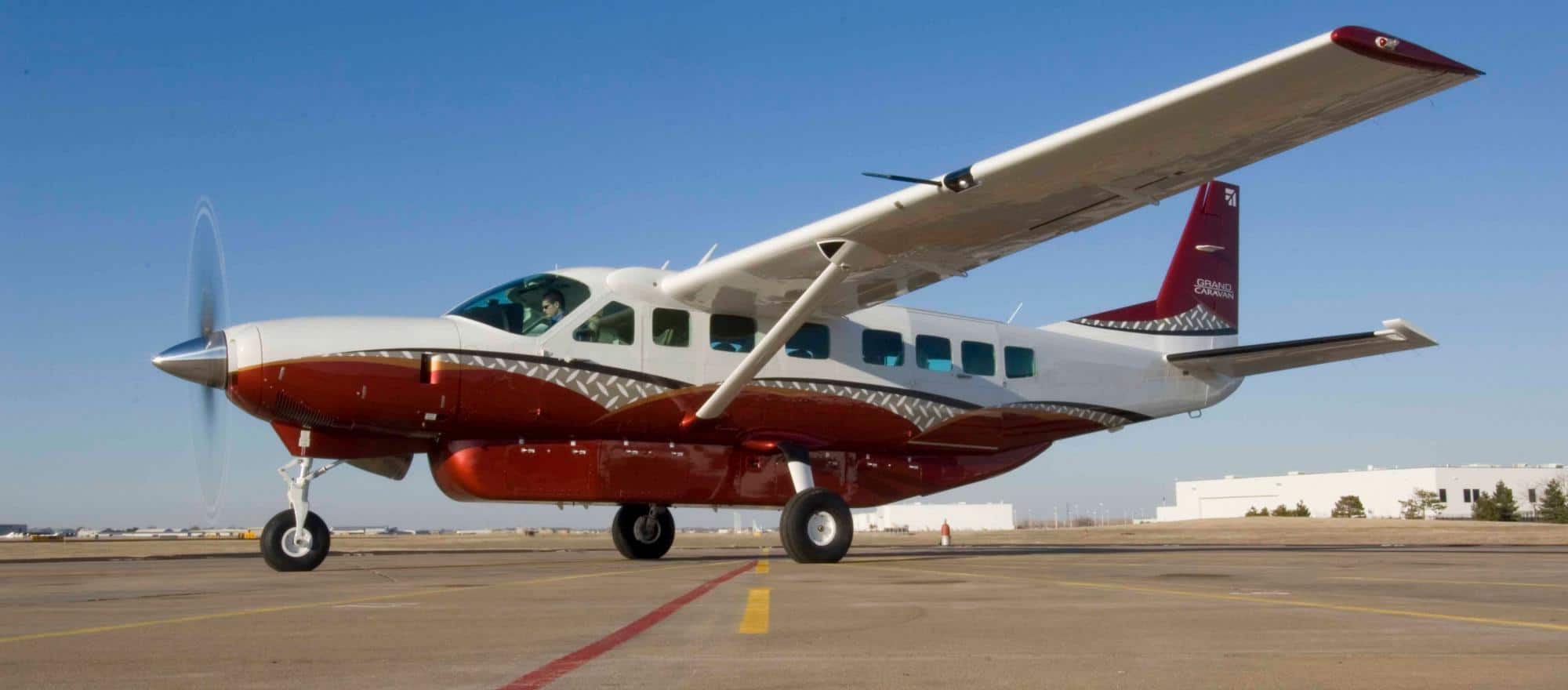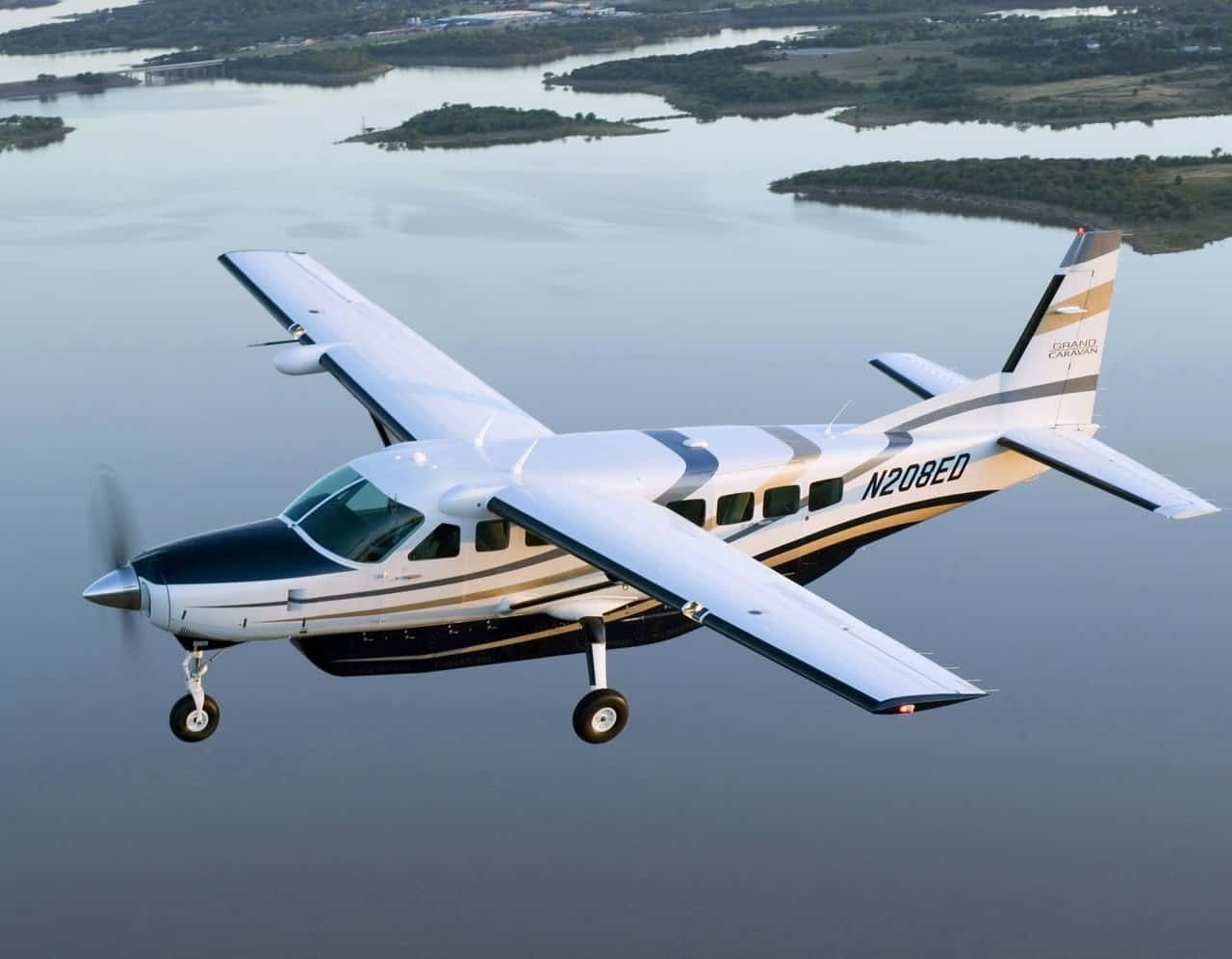Table of Contents
The Cessna 208 Caravan is the workhouse of the Cessna lineup. It’s considered dependable and efficient among charter services and small cargo transporters. Although single-engine powered, it delivers on power for routine flights or challenging landings on less than ideal runways. It needs just over 2,000 feet to get back in the air whether the track is smooth or rough.
*This post may contain affiliate links. As an Amazon Associate we earn from qualifying purchases.
The 208 comes in a handful of varieties from the original version to several aftermarket adaptations. Some militaries use the plane including the Brazilian Airforce and the Columbian Air Force because 900 nautical mile range makes it suitable for many duties inside the borders of Columbia and Brazil. The variations and aftermarket versions of the Cessna 208 include:
- 208A Cargomaster: This version lends itself the needs of cargo haulers like FedEx. It was developed with FedEx to handle their cargo moving needs.
- 208B Grand Caravan: This model is longer than the original Cessna 208 by four feet. Its original design is a two-seater built for cargo hauling. Later it became a passenger plane as well seating up to eleven people.
- 950 Grand Caravan: This is an aftermarket version with a 1,000-horsepower engine.
- U-27A: This is just the US Department of Defense’s name for the Cessna 208.
- AC-208 Combat Caravan: This model is unique in that it comes with Hellfire missiles mounted on it. You read that correctly, this model is a rocket carrying plane used by some Middle Eastern and African air forces and has air-to-surface missiles mounted on it.
An Overview Of The Cessna 208

The original airframe of the Cessna 208 comes with regular three-wheel landing gear. Some aftermarket models use skis or pontoons. Retractable landing gear is available on their own in a tricycle landing gear setup and with the pontoon landing gear. This selection of readily available landing gear reinforces the notion that the Cessna 208 is excellent at getting on and off rough runways.
The interior of the place doubles as passenger or cargo space. It’s versatile in the configuration allowing for passengers and cargo, just passengers, or only cargo. The most common passenger configuration seats up to thirteen passengers. A bonus cargo container on the bottom of the place is also an option for passenger commutes or hauling extra cargo. This plane is the definition of a versatile workhorse.
Let’s look at the technical specifications for the Cessna 208:
- Up to two crew including the pilot
- Nine passengers or thirteen with a special waiver
- The standard model is 37 feet 7 inches long
- The standard model carries a 52-foot 1-inch wingspan
- The standard model is 14 feet 11 inches tall
- It weighs 4,730 pounds dry and 8,000 pounds ready to fly
- It holds 2,224 pounds of fuel
- Its cruising airspeed is 214 miles per hour
- Its maximum range is 1,232 miles if empty and using the stock 675 horsepower engine
The real power behind the Cessna 208 is its versatility. It’s not very impressive as a stock plane, but if you add the cargo undercarriage and a 1,000-horsepower engine, it improves the range of the aircraft and shortens the necessary runway length. That’s just one modification scenario, and many more exist for this tough little plane.
What Makes The Cessna 208 Great?

Versatility is the greatest thing about this plane. It’s not ideal for commuter flights, but if you need to fly passengers and cargo into a rough area, this plane is the way to accomplish it. That said, it works excellent for nine passengers and their luggage if you need a short hop commuter plane solution. We only believe it’s not ideal because other options for commuter planes exist that offer more luxury.
The next best perk of owning a Cessna 208 is it’s economically friendly to fly. If you need to land on a dirt runway in a jungle or on the water next to an island, this plane makes it work and doesn’t cost a fortune to keep it in the air or maintained. The range of the aircraft is 1,000 miles, approximately, but that’s a long flight at a low fuel cost respectively.
While the plane seems like a no-frills workhorse, it comes standard with the Garmin G1000 NXi navigations and excellent display. The G1000 NXi is one of the most advanced flight deck management and navigation systems available on small planes like the Cessna 208. It dramatically improves safety on the ground and in the air along with providing precision navigation to get you where you want to go, reliably.
Should I Buy This Plane?
We’re glad you asked this question. Military uses aside, many companies that need to move cargo in and out of small airfields use this plane. FedEx is among those that employ the Cessna 208, modified, of course, to carry cargo into rural areas or anywhere that lacks a large airport. It saves a lot of time and money to drop cargo closer to its destination.
As we mentioned before, we don’t consider this plane ideal for commuter flights because it lacks luxuries passengers expect and at max capacity, it’s a little cramped in the cabin. It’s perfect for short, rough runways and makes an ideal cargo hauler if you need this service. It also converts into a spacious plane that suits the needs of skydivers. It easily carries five or so people and skydiving gear.
In short, if you operate a skydiving service or move a lot of cargo regularly, this plane is what you want to get into the areas larger planes just can’t manage safely. It works great as a passenger transport for outfitters that serve hunters, hikers, or anyone that wishes to reach remote locations for recreational reasons. Those passengers usually understand the lack of luxury on these flights.
If you’re considering buying a plane, you already know what you want or need. The good thing about the Cessna 208 is it provides versatility, utility, power, and a little fun to your flying. It’s very likely this plane fits what you’re looking for, especially if versatility and control are vital concerns. It does all this for you at $400 to $700 per hour of flight time, based on current fuel prices in your area.
How Much Does It Cost?
Prices for the Cessna vary wildly depending on which of the many versions or configurations you choose to buy. Before you start shopping for your new or used Cessna 208, consider what you plan to do with it. Modifying the plane after you buy it is a waste of money since almost any configuration or model you want is available new or used.
Used Cessna 208s online go for around $1,000,000 to $2,000,000. For instance, we found a 2011 Cessna 208 with amphibious landing gear for $1.9 million and a 2008 Cessna 208B Super Cargomaster for $1.6 million. Search for the plane you want before searching for the price you want. A new stock Cessna 208 costs between $2,000,000 to $2,800,000 depending on where you buy it.
Custom models get their price after you add all the options you want. Be careful and don’t get more than you need if ordering a custom model. Some of the custom configurations we played around with hit the $3,000,000 mark, and we were mostly conservative when selecting options and additions. The big price jumps include adding bigger engines, specialized landing gear, and extra cargo storage.
If you spend enough time shopping for these planes, you soon figure out they maintain a high resale value. They’re great planes and very durable if maintained properly, but the real reason for the high resale value is simple supply and demand. The demand for the Cessna 208 and its variants in countries in the Middle East and Africa is very high which helps hold the resale value higher than expected.
We mentioned a few times that these planes lack some of the luxuries you expect to find in commuter planes. To clarify, at full capacity and maximum cargo load, these planes lack luxury and might seem cramped to some passengers. However, luxury seating is available, but it limits passenger capacity and may increase the price of the plane. Our comments assume maximum passenger capacity.
Can I Fly A Cessna 208?

Assuming you are qualified and licensed to fly it, you’ll find flying the Cessna 208 is easy and it’ll impress you on the first takeoff. It does tend to turn left, but most planes won’t go straight unless you hold them steady. A little right rudder is all the Cessna 208 needs to stay lined up. Other than that, it lifts and flies like most high-wing planes.
A lot of effort is made to make flying these planes easy and hassle-free. From the hydromechanical fuel controller to the Garmin GFC700 Autopilot, you’ll find there’s a lot less leaning or stretching to get this plane going and off the ground. Actually, if you get it off the ground and back on the field, the GFC700 and the Garmin G1000 handle a lot of the flying between takeoff and landing.
What Do Pilots And Owners Think About This Plane?
These Cessna 208’s first flight was in 1982, and they’ve been in production since 1984. That fact alone is a good indicator that the planes perform well and endure regular use effortlessly. The next performance indicator is so many of these planes find their way into aftermarket fields like cargo hauling for FedEx and military use in various countries including the US. Don’t forget the Hellfire missiles.
Pilots hold these planes in high regards. It’s hard to find a negative comment about a Cessna 208 that’s made by a pilot. They’re easy to fly and easy to learn to fly, plus they’re comfortable compared to similar planes. Sometimes we wonder if plane manufacturers put things anywhere they’ll fit without considering the pilot at all. Cessna takes steps to make flying their aircraft comfortable and less taxing.
Owners that don’t fly planes themselves rarely complain about these planes. Depending on fuel prices in your area and your destination, it’s not unheard of to fly a Cessna 208 for as little as $400 an hour. Granted that’s pretty low fuel prices and low cargo weights, but you see our point. Typically, the Cessna 208 only requires a yearly inspection as well instead of phased inspections.
Passengers complain the most about the Cessna 208. The usual complaint is the cramped space on full capacity flights, but that’s typical of any small plane at max passenger capacity. Passengers on skydiving excursions or trips into small, rough airfields appreciate the agility of the Cessna 208. If you find yourself undecided, take a short flight on one and judge for yourself. Test flights make a difference.
The major complaints from owners and pilots fall into the fuel consumption category and noise levels. If you upgrade the engine in the Cessna 208 from the standard 675 horsepower engine to a larger engine like a 1,000-horsepower engine, it uses at least a third more fuel. In rough conditions or taking off with high cargo weights, it reduces the fuel economy even more. Bigger engines make more noise as well.
Is It A Safe Plane?
Fewer than 600 people died in accidents involving a Cessna 208 since it’s introduction over three decades ago. Most of the accidents involved some type of pilot error, but a few involved unforeseen things like mechanical failures or poor flying conditions. In some cases, bad luck played a significant role in our opinion like this incident in South Sudan when a Cessna 208B hit a cow. Yes, it hit a cow.
Conclusion
The Cessna 208 and all its variants prove themselves daily in rugged circumstances and routine flights. If you need a plane for general cargo hauling or moving passengers less than 1,000 miles, this plane won’t let you down. It does lack some luxury items, but it makes up for everything it’s missing in fuel efficiency and just being a great all-around plane.

